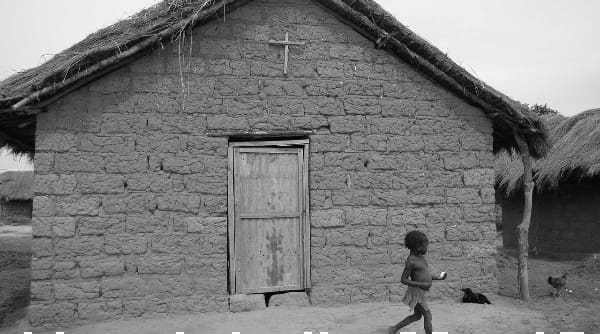Lepers are called the “impure ones,” but, thanks to the work of several associations, Raoul Follereau’s in particular, people’s minds are changing. The medical profession now knows that leprosy is not a curse but an illness that isn’t very contagious and that, above all, it can be treated. However, lepers are still living on the sidelines. They scare people. I’m attracted to them as I was attracted to the elderly people in my childhood, for I see that they need companionship. In fact, they need more than companionship. They need medical care. But what they suffer from the most is having society treat them as pariahs.
I got to know Véronique and Étienne, two lepers who were living in miserable conditions. Both were small and emaciated, like old wood. Étienne only had stumps of fingers on his right hand. Véronique had spots on her face and an ear that was damaged by the illness. They spent most of their time in a vacant house—away from the outside world. They scrounged for water and odds and ends to eat. Of course they welcomed the meals that St. Camillus prepared with pleasure, but they were both honored and frightened when I offered to bring the meals to their home. It was in this shelter of bricks that I assessed their misery—material, of course, but emotional, above all. Daylight didn’t enter their house. They didn’t want to be seen. Nobody knew them.
I went to see them from time to time. We talked about God and the upcoming Easter holiday. I perceived their sadness. They no longer had a family and would have to celebrate the Resurrection all by themselves. So I invited them to come to my house. Later, I did the same thing with other abandoned lepers, and since there were too many to fit my car, I chartered a bus that would bring them to my house. As is often the case, the small act of inviting a couple to the house took on rather large dimensions. Fortunately, Léontine shares my faith!
On Easter Day, I had some Italian friends from St. Camillus come for lunch at my house. The association started to be known by people in Europe, where we were raising money to help us in our mission. Among those who came for lunch was a priest who was visiting my country. While we were all talking together, the bus arrived in front of the house. There was a knock at the door. Léontine opened it, and the next moment, about forty lepers swamped the place. Some were missing fingers, feet, or a whole leg. The poor priest who, the moment before, had been chatting amiably with us, suddenly thought he was being thrown into the middle of a Court of Miracles. The lepers greeted our Italian friends to the best of their ability. Some magnificent smiles lit up their faces, many of which were ravaged by the disease. One of them exclaimed: “Grégoire, Léontine, Christ is risen!” The meal that followed was a bit odd but also festive and full of joy. It was impossible to know who was happier—they or I. The priest whom I involuntary put to the test still recalls this moment and often cites it in his sermons.
In the early days of St. Camillus in Bouaké in Côte d’Ivoire, I didn’t have much time to return to my native country to see my family. However, I was worried about Mama. I was her only child, and, above all, she had no faith. So I was very happy when I heard that she decided to enter the catechumenate. In 1987, we went to the Holy Land together, and she was baptized in the Jordan River.
A few years later, she died, and a lot of friends from St. Camillus were kind enough to attend her burial. I recognized Étienne among them. I recall his fingerless hand at the time of the collection; he reached into his pocket to try to grab a coin. He who was so poor. It was impossible not to make the connection with the widow that the Gospel of St. Mark talks about (12:41–44). Étienne, like the widow, didn’t give much, but, commensurate with his small savings, what he gave was huge. Sick people and little people really are our teachers in the Faith!
+
This article is adapted from a chapter in They Are Living in Chains by Grégoire Ahongbonon which is available from Sophia Institute Press.
Art for this post: Cover and featured image used with permission.





